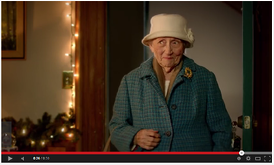Video: A Mighty Medium
There’s no denying that the growth of online video has become a major marketing consideration in the past few years. In December 2013, 188.2 million people in the U.S. watched 52.4 billion online content videos (comScore), and the number of online video users is expected to reach 1.5 billion by 2016 (Cisco). More than half of executives look for more information after seeing a product or service in a video (Forbes), and 57 percent of consumers say that product videos make them more confident in a purchase (MediaPost).
Why is video so powerful?
 Part of video’s appeal is its ability to tell a good story and to evoke emotion. Think about how you feel watching those adorable Cheerios ads, or the heartwarming Apple and Kohls commercials from this holiday season (darn those onions, am I right?). Many times a video can express something that words can’t. In fact, the information retained for one minute of online video is equal to that of 1.8 million written words, or about 3,600 web pages (Forrester via Video Brewery).
Part of video’s appeal is its ability to tell a good story and to evoke emotion. Think about how you feel watching those adorable Cheerios ads, or the heartwarming Apple and Kohls commercials from this holiday season (darn those onions, am I right?). Many times a video can express something that words can’t. In fact, the information retained for one minute of online video is equal to that of 1.8 million written words, or about 3,600 web pages (Forrester via Video Brewery).
Other times, video is a practical choice. Tutorial videos, for example, can help explain a difficult concept or product application. During the planning for the optics summer camp for inner city high school students, we watched a dozen engineers gather around a brief YouTube video explaining an optical design concept. It's a proven resource for this audience, as it conveys complex technical information in a more lucid, visual way.
What are some ways to use video?
There are many types of videos you can make besides the sentimental brand story and the pragmatic how-to. Here are some other options:
- Facilities tour – especially useful if you’ve just moved, expanded, or added capabilities
- Event teaser – preview a product or hint at a big announcement that will be made at a tradeshow, open house, or other event
- Event recap – can include clips from entire event, or showcase a particular moment; usually more interesting when edited together with a voiceover or interview clips
- FAQ – a nice supplement to your standard FAQ page on your website; opportunity to further explain with images or demos
- Interview with CEO – good for highlighting company vision, or a particular growth or change the company is going through
- Interview with engineer or other staff member – useful for showing expertise regarding applications or theories; or can be more HR-focused
- Testimonials or case studies – featuring customer successes benefits both you and them
- Just goofing off – keep it simple, light and fun; example: Jefferson Lab has fun with liquid nitrogen
Consider your end goals when deciding what kind of video to make. Are you trying to recruit new talent? Position your company as a thought leader? Help customers understand a new product? The format and content of your video should reflect what you ultimately want it to achieve.
What makes a good video?
Many factors contribute to video’s effectiveness, but in general, a good video is:
Relevant
 Videos should be pertinent to your target audience’s needs and interests as well as timely. Most often, timeliness will simply mean promoting your own product releases and events as they happen, but sometimes you might be able to tie your video into new industry developments or other current events. ASE Optics, for example, made a video in 2011 about their products for vibration control technology. In the video, they mentioned how this technology was used in aerial imaging to survey the 2010 Haiti earthquake damage. In this case, ASE cited an event still fresh in people’s minds and showed how their products were able to help in a difficult situation. Other companies, however, have gotten into trouble for inappropriate “newsjacking,” so if you’re going to reference current events in a business video, be sure to do it tactfully.
Videos should be pertinent to your target audience’s needs and interests as well as timely. Most often, timeliness will simply mean promoting your own product releases and events as they happen, but sometimes you might be able to tie your video into new industry developments or other current events. ASE Optics, for example, made a video in 2011 about their products for vibration control technology. In the video, they mentioned how this technology was used in aerial imaging to survey the 2010 Haiti earthquake damage. In this case, ASE cited an event still fresh in people’s minds and showed how their products were able to help in a difficult situation. Other companies, however, have gotten into trouble for inappropriate “newsjacking,” so if you’re going to reference current events in a business video, be sure to do it tactfully.
Reusable
While timely videos are more likely to be watched initially, the best videos stay relevant well past their initial post date. For example, the Google+ Hangout we hosted with one of our clients was a live event, but the resulting video remains a valuable source of information and continues to gain views on YouTube.
Good videos can do more than live on YouTube or Vimeo, however. Make the most out of your videos by promoting and leveraging them across multiple channels. Consider including video in:
- a blog post written specifically about the video [Fact: Blog posts that include video will attract almost 3 times more inbound links than plain text posts (Moz).]
- a related blog post
- your website (a product demo on a product page, an employee interview on your Careers page, a general “about us” video on your homepage or About Us page)
- a related email
- …and don’t forget to share on social media!
Even time-sensitive videos can be repurposed. For example, we recently re-promoted our client’s recap video of the 2013 APS March Meeting in lead-up to this year’s show.
Getting ready for APS March Meeting 2014? Watch our highlights video from last year's conference: http://t.co/kQpfBCkDev
— LakeShoreCryotronics (@LakeShoreCryo) February 21, 2014
Appealing (visually and aurally)
A messy backdrop or excess ambient noise can distract viewers from even the best story. That’s why adequate preparation and careful staging are crucial to making a good video. Here are some pointers we learned while working with Diffinity Genomics on their RapidTip for PCR Purification demonstration video:
- Check your surroundings – It’s important to take a thorough look at the area in which you’ll be filming, both through the camera lens and away from it. An interview with a scientist is much more interesting when filmed in the lab as opposed to a conference room; however, this “natural” environment might contain things that could detract from your video. Making sure the space is clean and uncluttered is important, particularly if you’re in a business such as medical devices where cleanliness is a top priority. Also check your shot for photos, signs, or other sensitive information you don’t want shared. Beware of mirrors or mirror-like surfaces that could reveal the cameraperson. Make sure you have sufficient lighting (no backlight!), and avoid environments with significant background noise.
 Prepare and practice – If you’re shooting the video yourself, you’ll want to do a test shot. This can be a random person talking about nothing in particular for a couple of minutes; you just need to know how it’s going to look. A memorized script always looks better than reading cue cards; if it helps to film in snippets, just make sure that you break in places that can be naturally filled with a product image or other clip to avoid awkward jumps. Make sure your speaker is centered in the frame and speaking to the camera; mark the floor so that they stand in the same spot for every take. Finally, get different camera angles, product shots, close-ups, etc. for added interest; it’s helpful to also plan these different shots ahead of time.
Prepare and practice – If you’re shooting the video yourself, you’ll want to do a test shot. This can be a random person talking about nothing in particular for a couple of minutes; you just need to know how it’s going to look. A memorized script always looks better than reading cue cards; if it helps to film in snippets, just make sure that you break in places that can be naturally filled with a product image or other clip to avoid awkward jumps. Make sure your speaker is centered in the frame and speaking to the camera; mark the floor so that they stand in the same spot for every take. Finally, get different camera angles, product shots, close-ups, etc. for added interest; it’s helpful to also plan these different shots ahead of time.- Keep the message clear – Don’t try to do too much in one video. Scientists and engineers often want to get deep into the details, and you might find yourself wanting to mention every awesome thing your company does. Nevertheless, by having a defined focus and staying on topic, you can create a clean, concise piece of content that resonates with viewers.
We had similar staging concerns when preparing for a Google+ Hangout with one of our clients. Check out the lessons learned from that experience in this post.
Compelling
At the end of the day, what you really want your content to do is make people act on what they saw. Often this means driving them to your website, but it could also mean signing up for a webinar or downloading a whitepaper. Each of your videos should have a clear call to action, whether it’s in the video itself, in the YouTube description, or next to it on a webpage (preferably all of the above). Video platforms such as Wistia and Vidyard allow you to create custom CTAs and forms to include right on the video screen [Bonus: They can both be integrated with HubSpot!]
With the right preparation and clear goals in mind, you can create intriguing videos that get results. To learn more about creating video and other content as part of your marketing strategy, give us a call.
